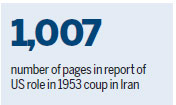US papers on 1953 Iran coup published
DUBAI, United Arab Emirates - Once expunged from its official history, documents outlining the US-backed 1953 coup in Iran have been quietly published by the State Department, offering a new glimpse at an operation that ultimately pushed the country toward its Islamic Revolution and hostility with the West.
The CIA's role in the coup, which toppled prime minister Mohammed Mosaddegh and cemented the control of the shah, was already well-known by the time the State Department offered its first compendium on the era in 1989. But any trace of United States involvement in the putsch had been wiped from the report, causing historians to call it a fraud.
The papers released this month show US fears over the spread of communism, as well as the British desire to regain access to Iran's oil industry, which had been nationalized by Mosaddegh.

It exposes "more about what we know about this milestone event in Middle East history and especially US-Iran history. This is still such an important, emotional benchmark for Iranians", said Malcolm Byrne, who has studied Iran at the nongovernmental National Security Archive.
The 1,007-page report, comprised of letters and diplomatic cables, shows US officials discussing a coup up to a year before it took place. While the US worried about Soviet influence in Iran, the British remained focused on resolving a dispute over the nationalization of the country's oil refinery at Abadan, at the time one of the world's largest. Many also feared further instability following the 1951 assassination of prime minister Ali Razmara.
"Nationalization of the oil industry possibly combined with further assassinations of top Iran officials, including even the shah, could easily lead to a complete breakdown of the Iran government and social order, from which a pro-Soviet regime might well emerge leaving Iran as a satellite state," one undated CIA analysis from the report warned.
Out of that fear grew TPAJAX, the CIA code name for the coup plot. Papers show the CIA at one point "stockpiled enough arms and demolition material to support a 10,000-man guerrilla organization for six months", and paid out $5.3 million in bribes and other costs, which would be equivalent to $48 million today. One CIA document casually refers to the fact that "several leading members of these (Iranian) security services are paid agents of this organization".
The CIA also described hoping to use "powerfully influential clergy" within Shiite Iran to back the coup, something that would be anathema by the 1979 Islamic Revolution. It offers no definitive proof of that, though several documents show US officials in contact with Ayatollah Abol-Ghasem Kashani, an anti-British leader in the Iranian parliament who turned against Mosaddegh.
The agency faced problems, however, chief among them Shah Mohammad Reza Pahlavi himself. Diplomats and spies referred to him as a "weak reed" and "petulant".
Mosaddegh was tipped off about the coup, and it appeared doomed as the shah fled to Baghdad and later Italy.
Associated Press
(China Daily USA 06/30/2017 page2)









